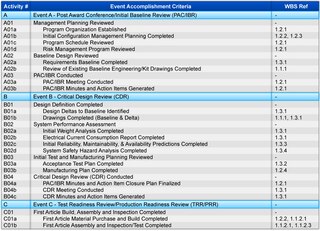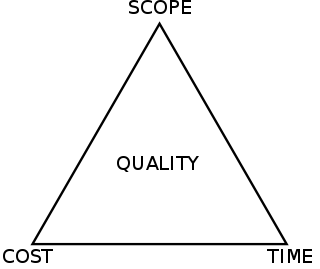Project management is the process of leading the work of a team to achieve all project goals within the given constraints. This information is usually described in project documentation, created at the beginning of the development process. The primary constraints are scope, time, and budget. The secondary challenge is to optimize the allocation of necessary inputs and apply them to meet pre-defined objectives.
Evaluation is a systematic determination of a subject's merit, worth and significance, using criteria governed by a set of standards. It can assist an organization, program, design, project or any other intervention or initiative to assess any aim, realisable concept/proposal, or any alternative, to help in decision-making; or to ascertain the degree of achievement or value in regard to the aim and objectives and results of any such action that has been completed. The primary purpose of evaluation, in addition to gaining insight into prior or existing initiatives, is to enable reflection and assist in the identification of future change. Evaluation is often used to characterize and appraise subjects of interest in a wide range of human enterprises, including the arts, criminal justice, foundations, non-profit organizations, government, health care, and other human services. It is long term and done at the end of a period of time.

In project management under the PRINCE2 methodology, a product breakdown structure (PBS) is a tool for analysing, documenting and communicating the outcomes of a project, and forms part of the product based planning technique.

PRINCE2 is a structured project management method and practitioner certification programme. PRINCE2 emphasises dividing projects into manageable and controllable stages.

In industry, Product Lifecycle Management (PLM) is the process of managing the entire lifecycle of a product from its inception through the engineering, design and manufacture, as well as the service and disposal of manufactured products. PLM integrates people, data, processes and business systems and provides a product information backbone for companies and their extended enterprises.
ISO/IEC/IEEE 12207Systems and software engineering – Software life cycle processes is an international standard for software lifecycle processes. First introduced in 1995, it aims to be a primary standard that defines all the processes required for developing and maintaining software systems, including the outcomes and/or activities of each process.
A responsibility assignment matrix (RAM), also known as RACI matrix or linear responsibility chart (LRC), describes the participation by various roles in completing tasks or deliverables for a project or business process. RACI is an acronym derived from the four key responsibilities most typically used: responsible, accountable, consulted, and informed. It is used for clarifying and defining roles and responsibilities in cross-functional or departmental projects and processes. There are a number of alternatives to the RACI model.
A product software implementation method is a systematically structured approach to effectively integrate a software based service or component into the workflow of an organizational structure or an individual end-user.
Product-based planning is a fundamental part of the PRINCE2 approach to project management, and is a method of identifying all of the products that make up or contribute to delivering the objectives of the project, and the associated work required to deliver them. The documents which define the Project itself are also considered Products.
Competence is the set of demonstrable characteristics and skills that enable and improve the efficiency or performance of a job. The term "competence" first appeared in an article authored by R.W. White in 1959 as a concept for performance motivation. In 1970, Craig C. Lundberg defined the concept in "Planning the Executive Development Program". The term gained traction when in 1973, David McClelland wrote a seminal paper entitled, "Testing for Competence Rather Than for Intelligence". The term was used by McClelland commissioned by the State Department, to extract characteristics common to high-performing agents of embassy, and to help them recruit and develop. It has since been popularized by Richard Boyatzis and many others, such as T.F. Gilbert (1978) who used the concept in relationship to performance improvement. Its use varies widely, which leads to considerable misunderstanding.
Software quality management (SQM) is a management process that aims to develop and manage the quality of software in such a way so as to best ensure that the product meets the quality standards expected by the customer while also meeting any necessary regulatory and developer requirements, if any. Software quality managers require software to be tested before it is released to the market, and they do this using a cyclical process-based quality assessment in order to reveal and fix bugs before release. Their job is not only to ensure their software is in good shape for the consumer but also to encourage a culture of quality throughout the enterprise.

In the United States Department of Defense, the Integrated Master Plan (IMP) and the Integrated Master Schedule (IMS) are important program management tools that provide significant assistance in the planning and scheduling of work efforts in large and complex materiel acquisitions. The IMP is an event-driven plan that documents the significant accomplishments necessary to complete the work and ties each accomplishment to a key program event. The IMP is expanded to a time-based IMS to produce a networked and multi-layered schedule showing all detailed tasks required to accomplish the work effort contained in the IMP. The IMS flows directly from the IMP and supplements it with additional levels of detail——both then form the foundations to implement an Earned Value Management System.
A glossary of terms relating to project management and consulting.

The project management triangle is a model of the constraints of project management. While its origins are unclear, it has been used since at least the 1950s. It contends that:
- The quality of work is constrained by the project's budget, deadlines and scope (features).
- The project manager can trade between constraints.
- Changes in one constraint necessitate changes in others to compensate or quality will suffer.
A phase-gate process is a project management technique in which an initiative or project is divided into distinct stages or phases, separated by decision points.
In software engineering, a software development process is a process of dividing software development work into smaller, parallel, or sequential steps or sub-processes to improve design, product management. It is also known as a software development life cycle (SDLC). The methodology may include the pre-definition of specific deliverables and artifacts that are created and completed by a project team to develop or maintain an application.
Macroscope is an integrated set of methods aimed at enterprise IT activities. Macroscope was developed and is maintained by Fujitsu in Canada. It is primarily used as their core body of knowledge to support the consulting services that they provide to their clients and is also licensed as a commercial product to a number of their clients
Performance-Based Building Design is an approach to the design of any complexity of building, from single-detached homes up to and including high-rise apartments and office buildings. A building constructed in this way is required to meet certain measurable or predictable performance requirements, such as energy efficiency or seismic load, without a specific prescribed method by which to attain those requirements. This is in contrast to traditional prescribed building codes, which mandate specific construction practises, such as stud size and distance between studs in wooden frame construction. Such an approach provides the freedom to develop tools and methods to evaluate the entire life cycle of the building process, from the business dealings, to procurement, through construction and the evaluation of results.
Small-scale project management is the specific type of project management of small-scale projects. These projects are characterised by factors such as short duration; low person hours; small team; size of the budget and the balance between the time committed to delivering the project itself and the time committed to managing the project. They are otherwise unique, time delineated and require the delivery of a final output in the same way as large-scale projects.
The following outline is provided as an overview of and topical guide to project management:




